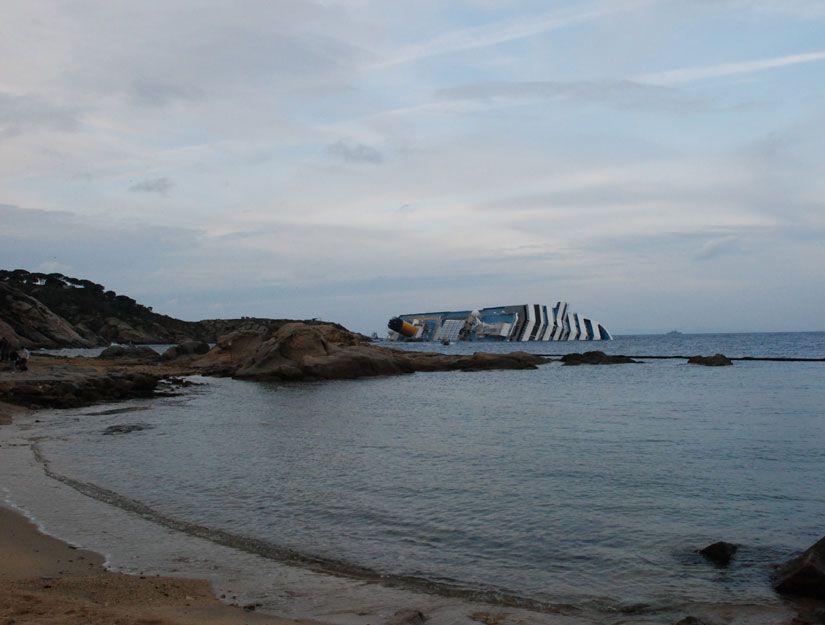
Concordia Not the First Sunk by Treacherous Reef

Costa Concordia captain Francesco Schettino wasn't the only seaman who drove his ship into the rocks off the Tuscan island of Giglio, ripping a huge gash in the hull that sent the 114,500-ton vessel tumbling onto its side.
Before him, other ship commanders had a close encounter with the cursed reefs that jut out off the island's coast.
PHOTOS: Recounting the Concordia Disaster
In fact, more than a dozen ancient ships rest in Giglio's treacherous waters.
One of them, a third-century Roman cargo vessel, lies about 1,000 feet south of the Concordia's bow at a depth of 130 feet.
Loaded with fish sauce-filled jars, the late Roman imperial ship was on the same route followed by Schettino on Jan. 13, when it struck the infamous stretch of rock known as Le Scole.
The ship had probably left the northern African coast some 1,700 years ago and was headed north when the collision occurred.
Sign up for the Live Science daily newsletter now
Get the world’s most fascinating discoveries delivered straight to your inbox.
"It was the same dynamics seen in the Concordia's accident. We do not know why the ancient ship sailed so close to the island. Possibly it was caught by a storm. I doubt the Romans were performing any near shore 'salute' maneuver," underwater archaeologist Enrico Ciabatti told Discovery News.
With the hull dramatically lacerated, the Roman vessel briefly continued to sail and was then pulled to its resting place by the current, just in front of Giglio Porto's red lighthouse. As it sank, the ship broke in two.
"Considering that the Concordia is nearly 1,000 feet long, she could have easily ended right on top of the Roman vessel in the very unfortunate case of a sinking," Ciabatti said.
Luckly enough for the more than 4,200 people aboard, the Concordia moved some 1,000 feet south and finally settled between the rocks of Punta del Lazzaretto and Punta Gabbianara.
According to Ciabatti, it's possible that most of the sailors from the Roman ship managed to survive the sinking, just like the majority of the Concordia's passengers and crew.
"The harbor, which already existed at those times, was easily reachable. The wreck lies just 160 feet offshore Giglio Porto," Ciabatti said.
With his colleague Paola Rendini, Ciabatti excavated part of the ship in the late 1980s, establishing that the vessel was 49 feet long and 16 feet wide.
"It wasn't a huge ship, but it was not easy to maneuver either, especially during a storm," Ciabatti said.
The jars, dishes and other items recovered from the ship are now on display at the permanent exhibition "Submerged Memories" at the Spanish Fortress museum in Porto Santo Stefano, near Grosseto.
The show reveals that many other wrecks lie off the Tuscan island. Indeed, heavy ship traffic passed through the 8-mile channel separating the Giglio island from the Argentario peninsula.
One ancient vessel, known as "Le Scole wreck" lies at a depth of 160 feet, not far from the vicious piece of rock now embedded in the Concordia's hull.
Two other Roman wrecks rest near Punta del Lazzaretto, not too far from the Concordia's stern. Other ancient wrecks lie at the northern end of the island, near Punta del Fenaio, Punta del Morto, Cala Calbugina and Secca della Croce, where sharp reefs line the shore.
While the remains of a so-called "galleon" lie at a depth of 98 feet at Punta Capel Rosso, the southern tip of the island, the? ?oldest deep-water wreck in history can be found in the waters of the Campese Bay,? ?on the northwest side of the island.
Found in? ?1961? at a depth of 180 feet near ?a reef,? ?the vessel, possibly of Greek origins, was excavated in the late? ?1980s. Its mixed cargo consisted of jars of East Greek, Phoenician and Etruscan goods, pottery, weights, lamps and arrowheads that dated the wreck to about 600 B.C.
?
After a long voyage from the Eastern Mediterranean 2,600 years ago, the ship ran into an off-shore reef known as Secca i Pignocchi.
"Rocks are like wreck magnets and ships run aground today in pretty much the same locations and for the same reasons they did thousands of years ago," underwater archaeology pioneer Edward Lee Spence told Discovery News.
According to Spence, who discovered the Civil War submarine H.L. Hunley, the SS Georgiana and many other historically significant shipwrecks, there have been over three million shipwrecks in the Mediterranean over the past 4,000 years.
"The most common cause of those wrecks has been running aground on reefs, rocks, shoals and even other wrecks. Indeed, it is not at all unusual to find wrecks on top of each other," Spence said.
This story was provided by Discovery News.











